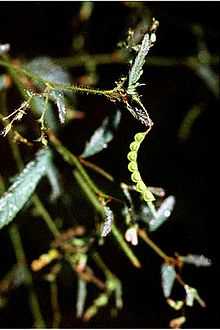Aeschynomene americana
| Aeschynomene americana | |
|---|---|
 | |
| Conservation status | |
| Scientific classification | |
| Kingdom: | Plantae |
| (unranked): | Angiosperms |
| (unranked): | Eudicots |
| (unranked): | Rosids |
| Order: | Fabales |
| Family: | Fabaceae |
| Genus: | Aeschynomene |
| Species: | A. americana |
| Binomial name | |
| Aeschynomene americana L. | |
Aeschynomene americana is a species of flowering plant in the legume family known by many common names, including shyleaf,[1] forage aeschynomene,[2] American joint vetch (United States and Australia), thornless mimosa (Sri Lanka), bastard sensitive plant (Jamaica), pega pega, pega ropa, antejuela, ronte, cujicillo, and dormilonga (Latin America).[3] It is native to Central America, parts of South America, the West Indies, and Florida.[3]
This plant is an annual or perennial herb growing up to 2 meters tall. The leaves are up to 7 centimeters long and have several pairs of linear to oblong leaflets. The sensitive leaves fold up when touched. The inflorescence is a raceme of flowers each up to a centimeter long. The flowers range in color from white to pinkish, orange, or purplish. The fruit is a curved legume pod up to 4 centimeters long made up of several jointed units, each unit containing a seed.[3]
This species is widely used as a green manure or pasture plant throughout the tropical world.[4] It is grazed by livestock and may be cut for hay.[5] Cattle readily eat the plant and spread the seeds on their coats and in manure. Available cultivars include 'Glenn'.[3]
In the wild it is generally a wetland plant, easily taking hold in wet places such as drainage ditches.[3]
References
- ↑ Aeschynomene americana. USDA Plants Profile.
- ↑ Thro, A. M., et al. (1990). Weed potential of the forage legume Aeschynomene (Aeschynomene americana) in rice (Oryza sativa) and soybeans (Glycine max). Weed Technology 4(2) 284-90.
- ↑ 3.0 3.1 3.2 3.3 3.4 Aeschynomene americana. FAO.
- ↑ Zhang, J. (1998). Variation and allometry of seed weight in Aeschynomene americana. Annals of Botany 82 843-47.
- ↑ Aeschynomene americana. USDA NRCS Plant Fact Sheet.
External links
- Dressler, S.; Schmidt, M. & Zizka, G. (2014). [http://www.africanplants.senckenberg.de/root/index.php?submitForm=true&page_id=77&searchTextMenue=Aeschynomene+americana&filterRegionIDs[]=6&filterRegionIDs[]=1&filterRegionIDs[]=2&filterRegionIDs[]=3&filterRegionIDs[]=5 "Aeschynomene americana"]. African plants – a Photo Guide. Frankfurt/Main: Forschungsinstitut Senckenberg.
